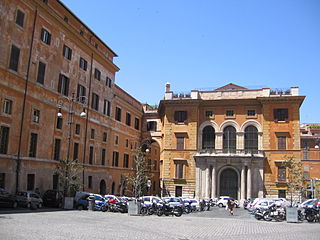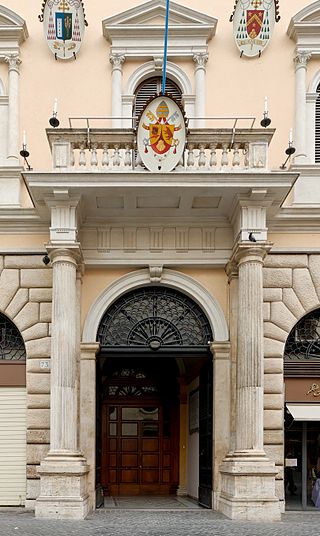
The Pontifical Gregorian University, is a higher education ecclesiastical school located in Rome, Italy.

The Pontifical University of Saint Thomas Aquinas (PUST), also known as the Angelicum in honor of its patron the Doctor Angelicus Thomas Aquinas, is a pontifical university located in the historic center of Rome, Italy. The Angelicum is administered by the Dominican Order and is the order's central locus of Thomist theology and philosophy.

Joseph Augustine Fitzmyer was an American Catholic priest and scholar who taught at several American and British universities. He was a member of the Society of Jesus (Jesuits).
The papal household or pontifical household, called until 1968 the Papal Court, consists of dignitaries who assist the pope in carrying out particular ceremonies of either a religious or a civil character.

The Pontifical Oriental Institute, also known as the Orientale, is a Catholic institution of higher education located in Rome and focusing on Eastern Christianity.

The Pontifical Biblical Institute is a research and postgraduate teaching institution specialised in biblical and ancient Near Eastern studies located in Rome. Founded in 1909 by Pope Pius X, it is an institution of the Holy See entrusted to the Society of Jesus (Jesuits). Since 1927, the Institute has had a branch in the city of Jerusalem.

The Pontificio Collegio Filippino, officially named the Pontificio Collegio Seminario de Nuestra Señora de la Paz y Buen Viaje, is a college for diocesan priests from the Philippines studying at pontifical universities in Rome, Italy.
The Pontifical Lateran University, also known as Lateranum, is a pontifical university based in Rome. The university also hosts the central session of the Pontifical John Paul II Institute for Studies on Marriage and Family. The university is known as "The Pope's University". Its Grand Chancellor is the Vicar General to the Holy Father for the Diocese of Rome. As of 2014 the Pontifical Lateran university had students from more than a hundred countries. It is also sometimes also known as the Pontifical University of Apollinaire.
The Pontifical Biblical Commission is a pontifical commission established within the Roman Curia to ensure the proper interpretation and defense of the Bible.

The Collegium Russicum is a Catholic college in Rome, originally founded by Pope Pius XI and dedicated to training priests for the newly organized Russian Greek Catholic Church.

Giovanni Mercati was an Italian cardinal of the Roman Catholic Church. He served as archivist of the Vatican Secret Archives and librarian of the Vatican Library from 1936 until his death, and was elevated to the cardinalate in 1936.
Franco Manzi is an Italian Catholic priest and academic.

The Roman Colleges, also referred to as the Pontifical Colleges in Rome, are institutions established and maintained in Rome for the education of future ecclesiastics of the Catholic Church. Traditionally many were for students of a particular nationality. The colleges are halls of residence in which the students follow the usual seminary exercises of piety, study in private, and review the subjects treated in class. In some colleges there are special courses of instruction but the regular courses in philosophy and theology are given in a few large central institutions, such as Pontifical Urbaniana University, the Pontifical Gregorian University, the Pontifical Lateran University, and the Pontifical University of Saint Thomas Aquinas, Angelicum.
Joseph Pathrapankal was an Indian New Testament Scholar and Syro-Malabar priest belonging to the Carmelites of Mary Immaculate.
Matthew Vellanickal is a New Testament scholar and a vicar general of the Syro-Malabar Catholic Archdiocese of Changanassery.
Fulcran Grégoire Vigouroux, was a French Catholic priest and scholar, biblical theologian, apologist, and the first secretary of the Pontificial Commission (1903–1912). Vigouroux defended the historicity of the Bible.
The Anselmianum, also known as the Pontifical Athenaeum of Saint Anselm is a pontifical university in Rome associated with the Benedictines. It offers courses in philosophy, theology, liturgy, monastic studies, languages, sacramental theology, and the history of theology.
Paul Joüon was a French Jesuit priest, hebraist, Semitic language specialist and member of the Pontifical Biblical Institute. Author of a philological and exegetical commentary on the Book of Ruth (1924), he also wrote A Grammar of Biblical Hebrew for which he received the Volney Prize from the Institute of France. First published in 1923, Joüon's grammar, enjoying numerous editions as well as an English translation, continues to serve as an important reference to this day.
Krikor Bedros XX Gabroyan, I.P.C.B. also known in English as Gregory Peter XX Gabroyan and in French as Grégoire Pierre XX Ghabroyan was the Catholicos-Patriarch of Cilicia of the Armenian Catholic Church after his election on 24 July 2015 and the necessary concession of the ecclesiastical full communion by Pope Francis one day later. He was enthroned on 9 August 2015.
Jan Lambrecht was a Belgian Catholic priest of the Society of Jesus, Professor Emeritus of New Testament and Biblical Greek at the Faculty of Theology and Religious Studies, KU Leuven, Belgium and a member of the Pontifical Biblical Commission. As a theologian, biblical scholar, and prolific author, he contributed numerous studies on almost all the books of the New Testament, but focused especially on the Gospels and the Pauline letters. His publications included books and articles written in English, Dutch, and French.

















